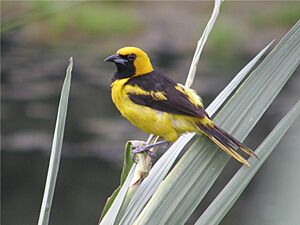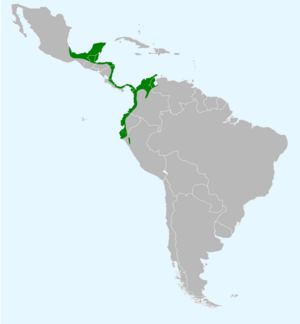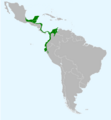Yellow-tailed oriole facts for kids
Quick facts for kids Yellow-tailed oriole |
|
|---|---|
 |
|
| Conservation status | |
| Scientific classification | |
 |
|
| Range of I. mesomelas |
The yellow-tailed oriole (Icterus mesomelas) is a beautiful passerine bird that belongs to the New World family Icteridae. These birds live in a wide area, from southern Mexico all the way down to western Peru and northwestern Venezuela. In Peru, they can also be found in special river valley areas that act like a wildlife highway.
Contents
What Does the Yellow-Tailed Oriole Look Like?
This oriole is about 22–23 cm (8.7–9.1 in) long, which is roughly the length of a ruler. It weighs around 70 g (2.5 oz), which is about as much as a deck of cards.
Most of its body is bright yellow. It has a black back, a black lower face, and a black upper chest. Its wings are black, but they have cool yellow patches on the shoulders, like epaulets on a uniform.
Its tail is very special! When you look at it from above, it's mostly black with yellow edges. But from below, it looks almost completely yellow. This is why it's called the yellow-tailed oriole – it's the only oriole with so much yellow on its tail!
Both male and female yellow-tailed orioles look very similar. However, young birds have olive-green feathers where the adults have black on their back and tail.
Different Kinds of Yellow-Tailed Orioles
Just like people from different regions might have slight differences, there are four main types, or subspecies, of the yellow-tailed oriole. They each live in slightly different places and have small variations in their looks:
- I. m. mesomelas: This is the original type. It lives from Mexico to Honduras. Its wing feathers have yellow edges.
- I. m. salvinii: You can find this type in the lowlands of Nicaragua and Costa Rica. It's a bit more orange than the first type and doesn't have yellow edges on its wing feathers.
- I. m. carrikeri: This one lives in Panama, Colombia, and northwestern Venezuela. It's similar to salvinii but less orange and has a smaller beak.
- I. m. taczanowskiis: This type lives along the Pacific coast of South America, from Ecuador to western Peru. Its wing feathers have white edges.
What Does the Yellow-Tailed Oriole Sound Like?
These birds have some interesting calls! They make a sound like chick and another like weechaw.
Their song is truly beautiful. It's a melodic tune with rich whistles, often sounding like chuck, chuck-yeeaow. Sometimes, the male and female sing together in a duet. The female's song might follow or even overlap with the male's longer phrases.
Where Do They Live and What Do They Eat?
The yellow-tailed oriole prefers to live in dense, thick areas. You'll often find them in swampy lowlands, hiding among vines, Heliconia plants, and other thick growths. They like places with lots of cover, more so than many other orioles.
These birds usually look for food in pairs or small groups. Their main diet is insects. However, they also enjoy eating nectar from flowers and certain fruits, like those from the gumbo-limbo tree (Bursera simaruba).
Reproduction and Nesting
When it's time to build a nest, the yellow-tailed oriole creates a deep but thin cup-shaped nest. They usually build it about 2 m (6.6 ft) high in a thorny bush, often near a stream.
The female bird lays three white eggs that have dark blotches on them. The eggs hatch in about 13 days. After hatching, the young birds stay in the nest for another 14 days before they are ready to fly out on their own.
Conservation Status
The yellow-tailed oriole is generally quite common in most places where it lives, except for parts of Peru and Venezuela. Sadly, their numbers are decreasing in some areas. This is mainly because people sometimes catch them to keep as pets. These birds are highly valued for both their striking looks and their lovely songs. It's important to protect them so they can continue to thrive in the wild.
Images for kids




